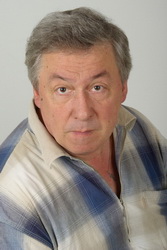Was born on July 1, 1952 in Kiev, a graduate of Kiev Theater University (1974). Starting as an actor in 1975, he worked his way up to director and artistic director of the Simferopol Crimea Maxim Gorky Academic Russian Drama Theater. Since 2007 he has taught acting and directing techniques at Simferopol’s Institute of Culture. Vladimir Denshchikov was awarded the title of Honored arts worker of the Autonomous Republic of Crimea and People’s artist of Ukraine. In 2009 he received an ARK prize for the achievements in “applied art”.
Vladimir Denshchikov paints his icons with the blessing of the clergy; many of his artworks were blessed by the Metropolitan of Simferopol and the Crimea Archbishop Lazarus and his spiritual father, Rev. Sergius, arch-priest of the beacon church of Nicholas the Wonderworker. Before painting an icon, Vladimir Denshchikov keeps a fast.
Denshchikov’s icons are distinguished by a remarkable atmosphere of light, kindness and peace. They are executed in macramé - a technique, applied by the painter for over 30 years. His recent icons have been created using his own patent hand-made fabric.
Vladimir Denshchikov’s icons are hand-knotted with linen threads (0.5-2 mm), with each knot being tied in hand, without needles and crotchets. Denshchikov does his artworks in one copy in accordance with the church canons, with each piece numbering several million knots. This technique is unique and has no analogues in the world.
An icon of 40 x 50 cm in size takes the artist from 3 to 6 months to execute. It took him 14 months to create an icon of Saint Prince Alexander Nevsky, which is made of 9 million hand-tied knots. The saints’ faces are painted in oil on the linen canvass.
Denshchikov’s artworks were exhibited in Germany, Austria, Ukraine and the Crimea, some of his icons are kept in private collections in Ukraine, Russia, Czechia, Hungary, Germany and the United States. In July 2010, Denshchikov’s icon of Tenderness was presented as a gift to His Holiest Patriarch of Moscow and All-Russia Kirill.
The scholar of Orthodox Christian iconography L.A.Uspensky wrote about innovative styles in iconography: “this icon, if its iconographic theme does not, of course, contradict the Orthodox teaching, i.e. is not heretical, may serve as a ground for the appearance of a new type of canonic icons, i.e. be accepted by the church.” Denshchikov’s icons are executed in accordance with strict canons.
